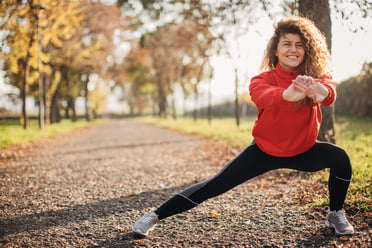We live in a world full of chaos, endless information, and never-ending to-do lists. It’s easy for our minds and bodies to become overwhelmed and fall into unhealthy coping habits. This is where mindfulness becomes so important. Mindfulness isn’t just quiet reflection—it’s the practice of staying present in the moment and taking time to reflect, reset, and recharge.

Less Stress, More Balance
Mindfulness helps your brain slow down and process the flood of information you take in every day. By pausing and focusing on your breath, you ground yourself and give your mind space to respond rather than react.
When you’re in “fight or flight,” it’s easy to rush to a solution without considering all your options. Staying present can lower tension, improve emotional balance, and give you greater mental clarity. Over time, this helps preserve your energy instead of draining it through constant stress responses.
Better Sleep
Do you struggle to unwind at night or replay everything you wish you had done differently? Mindfulness can calm racing thoughts and relax your body, making it easier to fall—and stay—asleep.
This leads to more energy, improved productivity, and greater presence throughout your day. Even a few minutes of mindful breathing before bed can help reset your nervous system and quiet those loud thoughts so you can rest fully.
Healthier Eating Habits
Mindfulness can also reshape your eating patterns. When you slow down and eat with intention, you’re less likely to overeat or grab less-nutritious choices out of habit. Paying attention to hunger cues helps you stop when you’re satisfied and choose foods that truly nourish your body.
How Can You Be More Mindful?
Mindfulness doesn’t have to look like the movie version of sitting cross-legged on the floor. It can be as simple as slowing down, grounding yourself with a few deep breaths, and giving yourself an extra moment before reacting.
Humans naturally react quickly, but that split second of pause helps break the cycle of stress-driven decisions. If you’re unsure where to start, try joining a yoga class here at NIFS. It provides dedicated time each week to reset your mindset, build awareness, and get back on track.
Mindfulness is a simple yet powerful tool that can reduce stress, improve sleep, and support healthier habits. With a few intentional pauses throughout your day, you can create more balance, clarity, and calm in your life.

 Colder, drier air, less sunlight, more time spent indoors, increased holiday travel, and more mixing and mingling all contribute to rising rates of illness in the winter months. While no single food or supplement can prevent or treat illness, a balanced diet with the right combination of key nutrients can support a healthy immune system—making it easier for your body to fight off illness and infection.
Colder, drier air, less sunlight, more time spent indoors, increased holiday travel, and more mixing and mingling all contribute to rising rates of illness in the winter months. While no single food or supplement can prevent or treat illness, a balanced diet with the right combination of key nutrients can support a healthy immune system—making it easier for your body to fight off illness and infection.
 Satiation
Satiation Thanksgiving is, in my opinion, the best holiday of the year. Theres no better way to express your love and care for someone than to make them a delicious meal and consume the delicious meal they made for you. Pair that with the added prospect of family members coming together from all over, and you’ve got great times waiting to happen. But sometimes love hurts, and on Thanksgiving that hurt takes the form of caloric surplus and post-meal shame. To prevent that, here are a few tips to help you enjoy the holiday to its fullest, free of any guilt:
Thanksgiving is, in my opinion, the best holiday of the year. Theres no better way to express your love and care for someone than to make them a delicious meal and consume the delicious meal they made for you. Pair that with the added prospect of family members coming together from all over, and you’ve got great times waiting to happen. But sometimes love hurts, and on Thanksgiving that hurt takes the form of caloric surplus and post-meal shame. To prevent that, here are a few tips to help you enjoy the holiday to its fullest, free of any guilt: Yoga and Stretch Classes
Yoga and Stretch Classes Feeling gratitude, or practicing it intentionally, can benefit our sense of happiness because we train our thoughts to entertain aspects of P.E.R.M.A. These thoughts serve our own greater good and connect us back to relationships, meaning, and life purpose. These thoughts are focused on things we value, regardless of the circumstances we are in.
Feeling gratitude, or practicing it intentionally, can benefit our sense of happiness because we train our thoughts to entertain aspects of P.E.R.M.A. These thoughts serve our own greater good and connect us back to relationships, meaning, and life purpose. These thoughts are focused on things we value, regardless of the circumstances we are in. Ready to bring more mindfulness and gratitude into your day?
Ready to bring more mindfulness and gratitude into your day?  Movement is considered one of the best forms of preventive medicine to protect our health. In a general sense, the more we move, the healthier we tend to be. Movement isn’t restricted to structured exercises. Your body doesn’t really differentiate between walking up a flight of stairs or stepping on a stair climber. The wonderful thing about physical activity is that our bodies inherently know how to recover and adapt.
Movement is considered one of the best forms of preventive medicine to protect our health. In a general sense, the more we move, the healthier we tend to be. Movement isn’t restricted to structured exercises. Your body doesn’t really differentiate between walking up a flight of stairs or stepping on a stair climber. The wonderful thing about physical activity is that our bodies inherently know how to recover and adapt. Intuitive eating is the practice of eating in response to your body’s internal hunger and fullness cues, rather than external cues, such as environmental or social triggers that prompt eating behaviors, regardless of true hunger or fullness levels. In today’s society, it is especially difficult to eat intuitively as we are near constantly being bombarded with messaging that tells us what we should or shouldn’t eat and that labels foods as “good” or “bad.” Overtime, as the mind and body become used to ignoring hunger signals, the cues begin to fade and are more and more difficult to notice or may only be noticed when the body is in an extreme, ravenous state, which is likely to lead to overeating, which is then followed by feelings of guilt and desire to restrict based on external cues and continued ignoring of internal hunger cues. For many, the body must be reconditioned, starting with reconnecting with your biological hunger cues. Here’s how to start:
Intuitive eating is the practice of eating in response to your body’s internal hunger and fullness cues, rather than external cues, such as environmental or social triggers that prompt eating behaviors, regardless of true hunger or fullness levels. In today’s society, it is especially difficult to eat intuitively as we are near constantly being bombarded with messaging that tells us what we should or shouldn’t eat and that labels foods as “good” or “bad.” Overtime, as the mind and body become used to ignoring hunger signals, the cues begin to fade and are more and more difficult to notice or may only be noticed when the body is in an extreme, ravenous state, which is likely to lead to overeating, which is then followed by feelings of guilt and desire to restrict based on external cues and continued ignoring of internal hunger cues. For many, the body must be reconditioned, starting with reconnecting with your biological hunger cues. Here’s how to start: As the days grow shorter and temperatures drop, finding motivation to get to the gym can be tough. Between an increase in sickness, schedule changes, and chilly weather, it’s easy to lose your fitness rhythm. But sticking with your exercise routine during this time of year can actually help you feel better. Regular movement can boost your immunity, improve your mood, and increase your overall energy levels.
As the days grow shorter and temperatures drop, finding motivation to get to the gym can be tough. Between an increase in sickness, schedule changes, and chilly weather, it’s easy to lose your fitness rhythm. But sticking with your exercise routine during this time of year can actually help you feel better. Regular movement can boost your immunity, improve your mood, and increase your overall energy levels..jpg?width=254&height=169&name=GettyImages-1053000236%20(1).jpg) Tips for Staying Active
Tips for Staying Active Weightlifting and resistance training are often associated with the “gym bro” or “jock” stereotype, as if the benefits only apply to people chasing new personal records or aesthetic goals. Because of that mindset, some might find it surprising to see an older adult in the weight room. If not to build muscle or break performance barriers, what’s the point? Wouldn’t it be dangerous for someone in their 50s, 60s, or beyond to lift weights? Surely nothing good could come from someone “older” picking up heavy objects regularly, right?
Weightlifting and resistance training are often associated with the “gym bro” or “jock” stereotype, as if the benefits only apply to people chasing new personal records or aesthetic goals. Because of that mindset, some might find it surprising to see an older adult in the weight room. If not to build muscle or break performance barriers, what’s the point? Wouldn’t it be dangerous for someone in their 50s, 60s, or beyond to lift weights? Surely nothing good could come from someone “older” picking up heavy objects regularly, right?